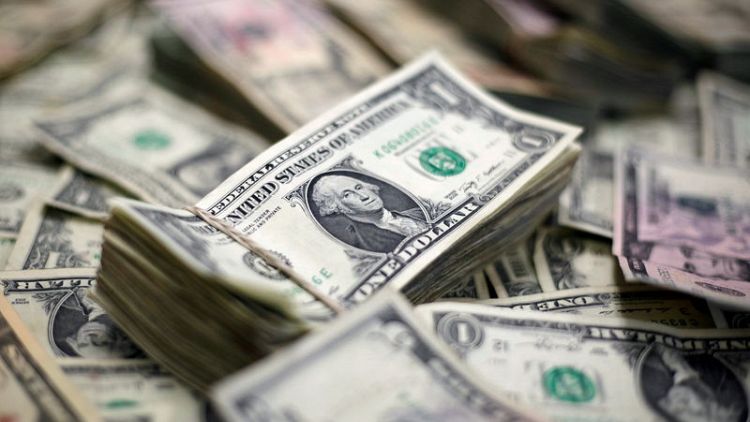By Caroline Valetkevitch and Saqib Iqbal Ahmed
NEW YORK (Reuters) - Late last month, the chief financial officer at Akamai Technologies Inc <AKAM.O> identified an emerging risk for the network technology company's profit outlook: the U.S. dollar.
Specifically, the surprisingly strong American dollar.
"We do expect some currency headwinds from the recent strengthening of the U.S. dollar over the last couple of weeks," Akamai CFO James Benson told analysts on an earnings conference call at the end of April.
Akamai, like hundreds of big U.S. companies, enjoyed a sales and profit boost from the dollar's steep decline through last year and into the first quarter of 2018.
But the greenback's downtrend abruptly reversed course in April as U.S. interest rates shot higher and European economic growth slowed. It now stands at the highest level in nearly seven months, meaning foreign currency earnings of U.S. multinationals can be worth less when translated back to dollars.
The dollar index <.DXY>, which measures the greenback against a basket of six currencies, has gained nearly 6 percent since April 17 but remains down about 2.7 percent year over year, as of Tuesday's close.
"It's too early to say we're going to see that impact show up in this next quarter, but I think we'll probably see it if it persists in the third quarter," said Paul Nolte, portfolio manager at Kingsview Asset Management in Chicago, referring to U.S. quarterly results.
Against the euro, the greenback is down 3.2 percent year-over-year, compared with a year-over-year decline of 14 percent in mid April. It hit a 10-month high on Tuesday as investors balked at the prospect of repeat elections in Italy, which may become a de facto referendum on Italian membership of the currency bloc.
U.S. dollar vs euro - https://reut.rs/2LaY2cj
Analysts expect profit growth for S&P 500 companies to begin to slow, according to Thomson Reuters data, with first quarter's 26.3 percent increase possibly representing a peak for the current earnings up trend. S&P 500 earnings have gained year-over-year since the third quarter of 2016.
They are forecasting profit growth of 22 percent for all of 2018 and 2019 growth to slow to 9.5 percent, based on the data.
The first-quarter jump in earnings - the biggest year-over-year increase since the fourth quarter of 2010 - was largely due to the corporate tax cuts that went into effect this year.
But Bank of America Merrill Lynch estimates currency moves in the first quarter provided a 2 percentage-point benefit to sales growth, the biggest boost from currency changes in six years.
The bank has estimated that in general a sustained 10 percent appreciation in the dollar results in a reduction in S&P 500 earnings per share of 3 to 4 percent.
Companies from many industries pointed to the dollar as a benefit to sales and earnings in the first quarter, including Apple Inc <AAPL.O>, Bristol-Myers Squibb Co <BMY.N>, Mattel Inc <MAT.O>, PayPal Holdings Inc <PYPL.O>, Tapestry Inc <TPR.N> and Intuitive Surgical Inc <ISRG.O>.
In Akamai's case, it added 5 percentage points to first-quarter profit and 2 points to its sales.
For Facebook Inc <FB.O>, a weaker dollar in the first quarter added $536 million to its revenue, increasing the social media company's top line by 49 percent, instead of 42 percent without the foreign exchange effect.
S&P 500 companies that generate 50 percent or more of their revenue outside the United States are on track for a first-quarter earnings increase of 30.5 percent, while companies that generate less than 50 percent of their revenue outside the United States are on track for a 24.8 percent earnings increase, based on Thomson Reuters data.
Analysts estimate that between 40 percent to 50 percent of S&P 500 sales come from abroad, with Asia and Europe accounting for the biggest portion.
"If the political situation in Italy worsens, the longer-term spillovers would be felt in the U.S. via a stronger dollar and lower European growth. This would act as a headwind, especially for some multinationals' corporate profits," said Mohamed El-Erian, chief economic adviser at Allianz in Newport Beach, California.
To be sure, many analysts are sceptical the dollar strength will persist.
Sameer Samana, global equity and technical strategist at Wells Fargo Investment Institute in St. Louis, said he expects the dollar to decline into the year end, citing pressure from the U.S. deficit.
Yet, at its current pace, the dollar index could turn positive on a year-over-year basis sometime later this quarter or early in the third quarter.
Karl Schamotta, director of global product and market strategy at Cambridge Global Payments, in Toronto, said he had seen an increase in hedging activity, particularly companies that are exposed to a falling euro and Canadian dollar.
"Both of these factors are driving a pretty pronounced increase in hedging activity using forwards and options," said Schamotta, referring to companies' use of derivatives to minimize foreign exchange risks.
Some equity strategists said next year could be the bigger problem if the dollar continues on its current path.
"If you measure on a year-over-year basis, the comps are going to look terrible," said Robert Phipps, a director at Per Stirling Capital Management in Austin, Texas.
(Reporting by Caroline Valetkevitch and Saqib Iqbal Ahmed; additional reporting by Noel Randewich in San Francisco, and Lewis Krauskopf, Chuck Mikolajczak, Sinead Carew, April Joyner and Jennifer Ablan in New York; Editing by Alden Bentley and Susan Thomas)



